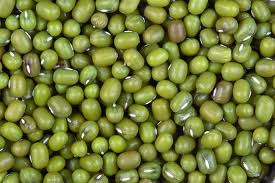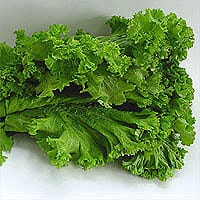Kale or borecole is a form of cabbage (Brassica oleraceaAcephala Group), green or purple, in which the central leaves do not form a head. It is considered to be closer to wild cabbage than most domesticated forms. The species Brassica oleracea contains a wide array of vegetables includingbroccoli, cauliflower, collard greens, and brussels sprouts. The cultivar group Acephala also includes spring greens andcollard greens, which are extremely similar genetically.
Kale is an archaic type of cabbage that grows loosely furled leaves, rather than forming a head. The leaves of kale have a distinctive ruffly appearance that distinguishes the plant from a close relative, collard greens. Kale tends to be a little bit bitter in flavor, although this bitterness is tempered by washing, cooking, and using younger leaves. Kale is also extraordinarily nutritionally rich, even among the leafy green vegetables.
Kale originated in Asia Minor and descended from a wild cabbage. Celtic roamers introduced Europe to Kale around 600 BC, and it thrived on the coastal southern and western regions. In time, it became a popular vegetable.
Health Benefits of Kale
- The beneficial effects of cruciferous vegetables like kales over cancer have been known for a long time. The vegetable is very effective in reducing the risk of lung, breast, bladder, colon and ovarian cancer.
- Indole-3-carbinol, a phytonutrient present in cruciferous vegetables like kales, helps to reduce the secretion of apolipoproteinB-100 (a cholesterol transporter) by the liver cells. This transporter is the prime carrier of LDL (Low Density Lipoprotein) to tissues and increased levels of this cholesterol lead to plaque formation in the blood vessels. Thus, by lowering the secretion of the transporter, the vegetable helps to prevent a number of ailments related to the cardio-vascular system.
- There is a direct connection between vitamin A, lung inflammation and emphysema. Studies have proved that a particular carcinogen present in cigarette smoke, benzo(a)pyrene, causes vitamin A deficiency in the body. Thus, to counteract this effect; the daily diet of a person should have high contents of vitamin A.
- Research has also indicated that intake of vitamin C rich foods such as kales acts against inflammatory polyarthritis, a type of RA (Rheumatoid Arthritis) that involves two or more joints.
- The high fiber content in kales helps to reduce high cholesterol levels and thus helps to prevent atherosclerosis. It is estimated that a single cup of kale supplies around 10.4% of the daily fiber requirement.
- Apart from this, kale also helps to maintain the normal blood sugar level and hence, is very advantageous for people suffering from diabetes.
- Kale contains high calcium content. Calcium is vital for the development and maintenance of healthy bones. A cup of kale provides approximately 9.4% of the daily calcium requirement.
- The vegetable is also a very good source of the trace element, manganese. This mineral takes part in a number of chemical processes in the body and helps in the production of energy from carbohydrates and proteins. Also, it is involved in the synthesis of certain fatty acids that are essential for the proper functioning of a healthy nervous system.
- Manganese is a critical component of an antioxidant enzyme called superoxide dismutase (SOD) which is exclusively found inside the body mitochondria. Here, it provides defence against the harmful effects of certain free radicals that are produced during the process of energy production.
- The presence of certain organosulfur phytonutrients in kale helps to reduce the risk of certain types of cancer in humans like bladder cancer and colon cancer and helps in the general strengthening of the immune system of the body.

